Heart leaf philodendrons are wonderful vining plants that can thrive for decades with the right care. In this post, I’ll tell you everything you need to know about how to grow them, so you can have the best success.
The beautiful leaves on long vines make the heart leaf philodendron easy to love. They’re also simple to care for, even for beginners.
Below you’ll learn how to care for your heart leaf philodendron including water, light, and soil requirements, as well as tips on growing them like a pro.
You’ll also learn how to prune, propagate, troubleshoot problems, and more, so you can enjoy them for decades to come.
What Is A Heart Leaf Philodendron?
Heart leaf philodendron or ‘philo’ (Philodendron hederaceum) is an evergreen tropical plant native to South America.
The heart shape of the leaves earned it the common name, as well as the nickname ‘sweetheart vine’.
Glossy leaves, ranging from 2-4” wide, emerge bronze, then turn deep green. The trailing vines can reach 10’ or longer over time.
The fast-growing vines can be trained vertically, but also look lovely draping from a high shelf or hanging basket.
As an added bonus, they’re considered a great choice for keeping your homes air cleaner.
Different Philodendron hederaceum Varieties
The most well-known Philodendron hederaceum features deep green, glossy leaves. But there are different varieties that showcase an array of colorful foliage. Here are a few of the most common.
- Neon – A bright variety with yellowish-green leaves and vines.
- Brasil – Dark green leaves are swirled with a pale green stripe, often near the tips.
- Variegated – White mottling spreads across the deep green foliage.
- Micans – Velvety textured leaves showcase hints of bronze coloring.
Toxicity
According to the ASPCA website, the heart leaf philodendron can be toxic to cats and dogs if ingested.
So if you’re concerned about that, it’s a good idea to keep it out of reach of pets and young children.
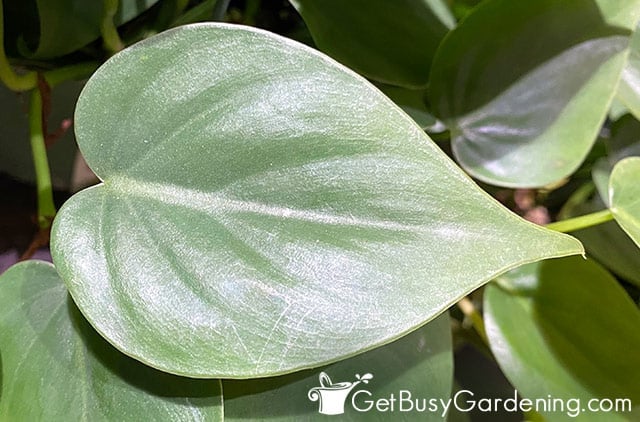
How To Grow Heart Leaf Philodendron
Before we get into the details of heart leaf philodendron care, first we should discuss the best location to grow one. The right spot will help it thrive for many years.
Hardiness
Philodendron hederaceum are excellent year-round houseplants, but aren’t as tolerant of outdoor environments.
They’re hardy only in zones 10+, but really prefer the temperature to stay above 60°F at all times.
If it gets much colder, it can damage the leaves, cause them to drop off, and eventually kill the plant. So bring them inside before the temps are too low in the fall.
Where To Grow Philodendron hederaceum
If you live in a warm climate, you can plant a heart leaf philodendron in the garden in a shady spot. They burn easily under direct sun.
Otherwise, choose a location indoors that gets plenty of bright, indirect light to encourage bigger, glossier leaves, and faster growth.
Select a container that has good drainage, and either hang it or place it in a location that will showcase the beautiful draping vines.
When the weather is warm enough, they can enjoy outdoor time in a protected area, like a porch or well shaded garden spot.
Related Post: 15 Easy Indoor Plants That Anyone Can Grow

Heart Leaf Philodendron Plant Care & Growing Instructions
Now that you have the perfect growing location in mind, it’s time to talk about heart leaf philodendron care. Here you’ll find my best tips for keeping any variety you have healthy and happy.
Light
Heart leaf philos prefer bright, indirect light, but are tolerant of a wide variety of indoor conditions.
Always keep them out of any direct sun to prevent scorching and foliar damage. Low or fluorescent lighting is fine, but it can affect the size and speed of their growth.
If you notice small leaves or sparse vines, consider adding a grow light or moving it to a brighter location.
Water
In the spring and summer, keep the soil lightly moist, giving them a drink when it’s dry 1” down.
Never allow it to become completely saturated or soggy though. Overwatering is a common cause of root rot and yellow leaves.
They’ll require less in winter or low light conditions, but never let them become bone dry for extended periods. Brown or curling leaves are telltale signs of a thirsty sweetheart vine.
If you struggle with this, I recommend investing in a moisture gauge to help you out.
Humidity
They love humidity, and will appreciate an occasional misting. It can even encourage larger leaves and faster growth.
But heart leaf philodendrons are tolerant of average household humidity as well.
If you notice brown tips, adding a pebble tray or a humidifier can increase the moisture in the air. Or, wipe down the leaves with a damp rag, which also keeps them clean.
Avoid letting water sit on the leaves for more than a few hours however, as that can cause spotting.
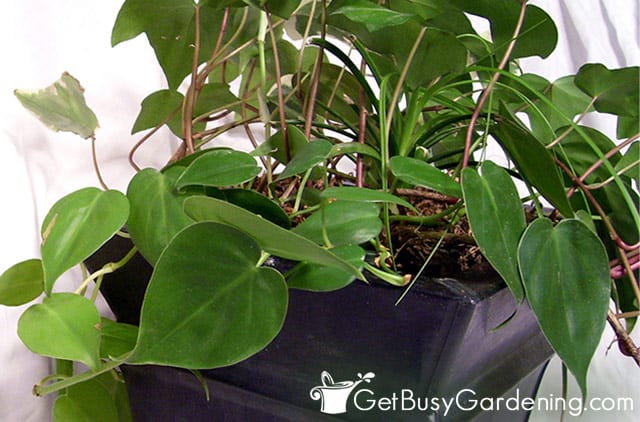
Temperature
Philodendron hederaceum are excellent indoor plants because they thrive in the controlled temperature of most homes.
A 65-80°F range is ideal. When it drops cooler than 60°F, it will slow their growth, and could cause damage outdoors. Hotter temps can make them dry out faster, and even cause wilting.
Fertilizer
Though it’s not required, heart leaf philodendrons will appreciate a monthly application of fertilizer as part of their regular care. It helps maintain their color and encourages larger, healthier foliage.
Use a natural liquid houseplant fertilizer or compost tea during the spring and summer. Or add slow-release granules one to two times a year.
Stop fertilizing completely in the fall and winter. I also recommend avoiding chemical options, as they can damage and burn the leaves.
Soil
Using a general purpose soil is completely fine for potting your heart leaf philo. They aren’t that picky.
But to create the best environment, use a well-draining mixture that is rich with organic matter. Mix potting soil with worm castings and perlite to make your own.

Repotting
You’ll only need to think about repotting every 2-3 years. But severely root-bound heart leaf philodendrons can start to suffer if left growing in the same pot for too long.
In the spring, look for roots peeking out of the drainage holes or on top of the soil to know it’s time.
Water the day before to help loosen the roots. If necessary prune the long vines to make it easier to manage.
Place it into a container no more than 2” larger than its previous one. Bury it at the same depth, and thoroughly moisten the soil.
Pruning
Pruning a heart leaf philodendron isn’t necessary for successful care. But, if the vines are long, sparse, or they have discolored foliage, you can trim them back in the spring or summer.
Use sharp, sterile precision pruners to snip the vines just above a leaf node. Make a clean cut, and new leaves will branch out from that spot.
It’s a great way to encourage a bushier, more compact plant, rather than long spindly vines.
Pest Control Tips
Healthy Philodendron hederaceum plants rarely have issues with pests. However occasionally spider mites, mealybugs, aphids, or scale can occur, especially indoors.
Thankfully, you can treat them with natural solutions, like neem oil spray, insecticidal soap, or by applying rubbing alcohol directly to the bugs with a cotton swab.
You can even make your own insecticide by mixing 1 teaspoon of mild liquid soap with 1 liter of water. Wash the leaves and stems to immediately begin controlling the problem.
Heart Leaf Philodendron Propagation Tips
Heart leaf philodendrons are very easy to propagate with either stem cuttings or by root division. And, with a fast-growing plant like this one, you’ll have plenty of opportunities.
Healthy cuttings can be rooted in the spring and summer in either water or soil. Take a clean cut just below a set of nodes, and dip it in rooting hormone.
Place it in a pre-moistened medium, and keep it somewhere warm, bright, and humid. In 3-4 weeks roots and new growth will appear, and you can pot them up.
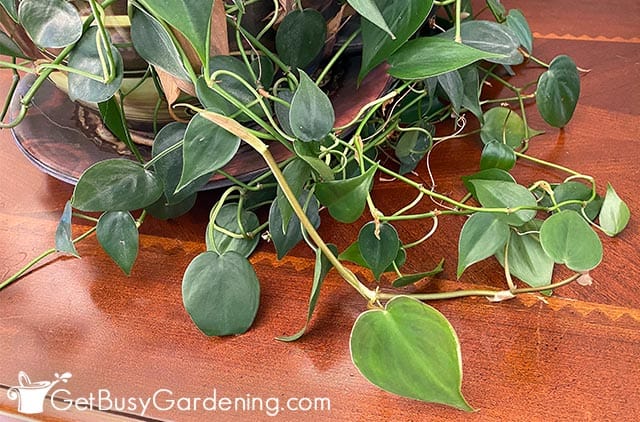
Troubleshooting Heart Leaf Philodendron Care Problems
With the right care, your heart leaf philodendron will thrive without much attention. But over the years you may run into these common issues. Here are my best tips for getting them back to good health.
Heart Leaf Philodendron Not Growing
There are a few reasons why your heart leaf philo has slowed or stopped growing. It could need repotting, fertilizer, or more light.
Add a grow light or move it to a brighter location if it’s too dark. You could also try giving it a dose of fertilizer if you haven’t fed it in a while, and repot into a larger container if it’s root-bound.
Yellow Leaves
Yellow leaves are most often a sign of overwatering. Heart leaf philodendrons will quickly fade from green to yellow if they have soggy feet for too long.
However, if only the occasional one yellows and drops off, it’s nothing to worry about. This is normal behavior that tends to happen as they age.
Leaves Turning Brown
Brown leaves, tips, or spots on your Philodendron hederaceum could be caused by lack of moisture or humidity, fungus, fertilizer burn, or sunburn.
Always protect it from direct sun, and keep the soil evenly moist. If you suspect fertilizer burn, flush the pot with fresh water for several minutes, and drain off any excess.
For lack of humidity, set the container on a pebble tray, or mist more often. Always wipe the leaves clean of any sitting water to prevent fungus.
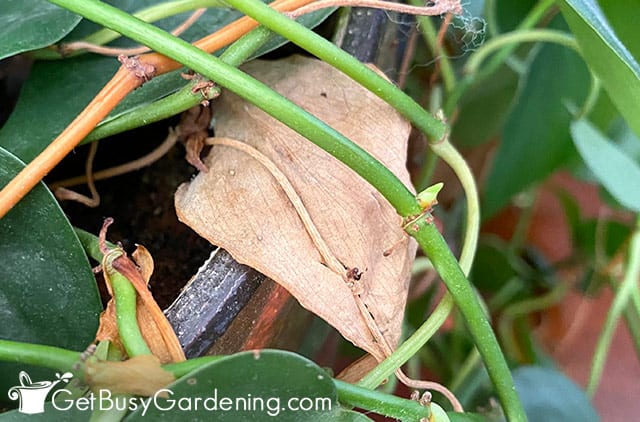
FAQs About Heart Leaf Philodendron Care
Here I’ve answered some of the most commonly asked questions about heart leaf philodendron care. If yours isn’t on this list, please ask in the comments section below.
Do heart leaf philodendrons grow fast?
Heart leaf philodendrons do grow fast in bright light and humid conditions. You can also encourage faster growth with fertilizer, and by maintaining good watering practices.
Can you grow heart leaf philodendron in water?
Yes you can grow heart leaf philodendron in water, in fact it’s a simple and effective way to root cuttings. However, I don’t recommend leaving them in there for too long. It can cause rotting and make the transition back to soil very difficult.
Can I put my heart leaf philodendron outside?
Yes, you can put your heart leaf philodendron outside when the temperature remains above 60°F. Choose a shady spot to prevent sunburn.
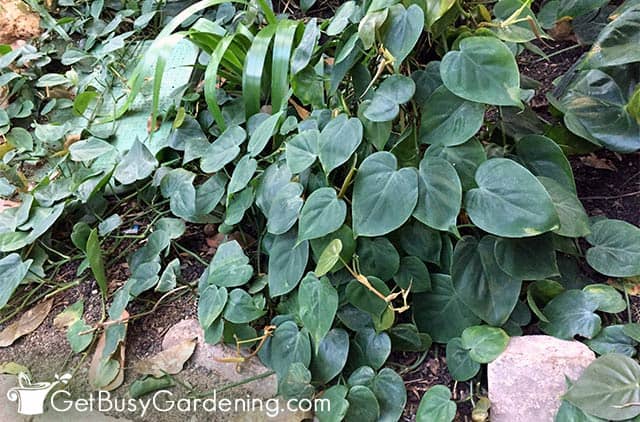
Should I mist my heart leaf philodendron?
You should mist your heart leaf philodendron if your home has dry air, or you notice brown tips on the leaves. They thrive in high humidity, and appreciate an occasional misting.
How much sunlight does a heart leaf philodendron need?
A heart leaf philodendron needs bright, indirect sunlight, but can also tolerate lower light or fluorescents. Slow growth, smaller leaves, and loss of color can indicate the need for more.
How do you make a heart leaf philodendron bushy?
To make your heart leaf philodendron bushy, prune it regularly in the spring by trimming the vines back to the desired length, just after a set of nodes.
The low maintenance heart leaf philodendron makes an excellent plant for beginners and advanced indoor gardeners alike, especially when you follow the care tips included here.
If you want to learn all there is to know about maintaining healthy indoor plants, then you need my Houseplant Care eBook. It will show you everything you need to know about how to keep every plant in your home thriving. Download your copy now!
More Houseplant Care Guides
- How To Care For A Pink Princess Philodendron
- How To Care For A Philodendron Birkin Plant
- How To Care For A Pothos Plant (Devil’s Ivy)
- How To Care For Purple Heart Plant (Purple Queen, Tradescantia pallida)
- How To Care For Chinese Evergreen (Aglaonema)
- How To Care For Sago Palm Trees (Cycas revoluta)
- How To Care For Alocasia Plants
Share your heart leaf philodendron care tips in the comments section below.


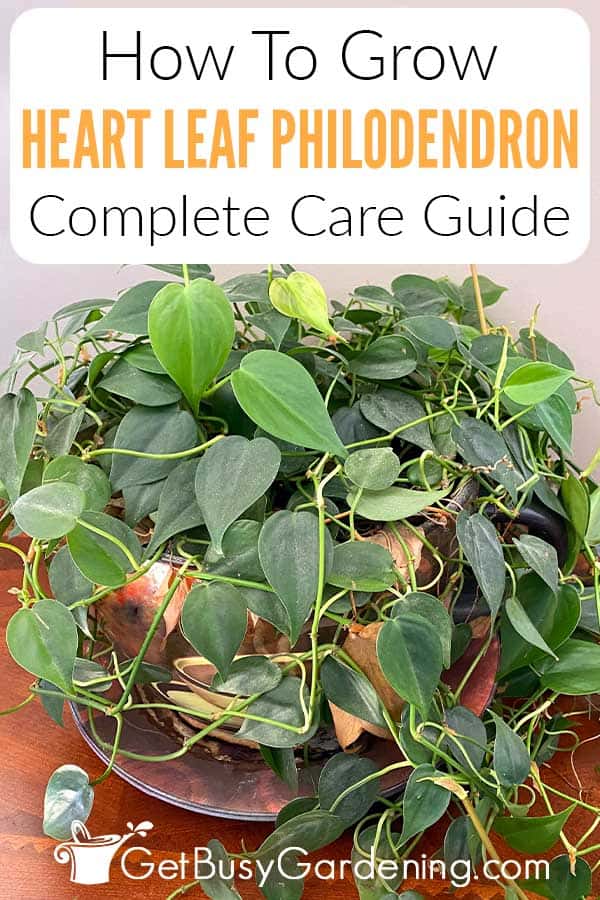
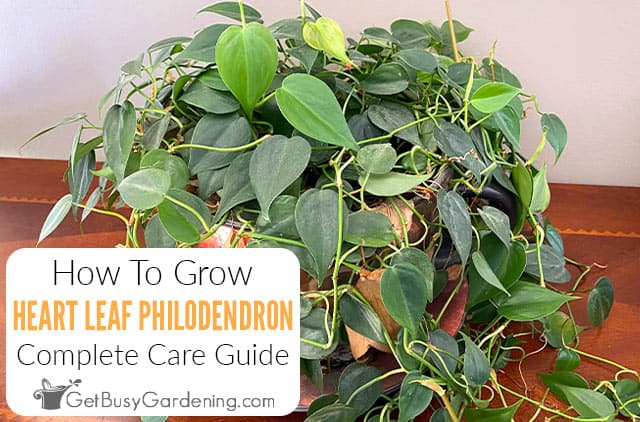




Nancy says
Does the heart philadaderion get flowers
Amy Andrychowicz says
Yes, heart leaf philodendrons can get flowers, but it’s very uncommon and the blooms are small and insignificant.